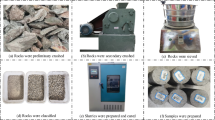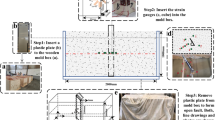Abstract
Active fault creep slip induces deformation of rock mass buried deeply in fault zones that significantly affect the operational safety of long linear projects passing through it. Displacement distribution patterns of rock masses in active fault zones which have been investigated previously are the key design basis for such projects. Therefore, a discrete element numerical model with different fault types, slip time, dip angles, and complex geological features was established, and then the creep slip for normal, reverse, and strike-slip faults were simulated to analyze the displacement distribution in the fault rock mass. A disk rotation test system and the corresponding laboratory test method were developed for simulating rock mass displacement induced by creep slippage of faults. A series of rotation tests for soft-and hard-layered specimens under combined compression and torsional stress were conducted to verify the numerical results and analyze the factors influencing the displacement distribution. An S-shaped displacement distribution independent of fault dip angle was identified corresponding to reverse, normal, and strike-slip faults. The results indicated that the higher the degree of horizontal extrusion, the softer the rock mass at the fault core, and the higher the degree of displacement concentration in the fault core; about 70% of the creep slip displacement occurs within this zone under 100 years of creep slippage.
摘要
活断层的蠕滑错动对穿越其中的隧洞(道)、管线等长线工程的运行安全影响巨大, 工程沿线活 断层蠕滑位移分布模式是此类工程建筑物的重要设计依据。基于断层带的活动特征、地质条件以及各 区域内的岩体性质, 采用离散元方法建立了不同类型和倾角的断层数值模型。将活断层的蠕滑错动相 似比拟为地质分层间的持续性剪切, 研制并采用了圆盘旋转试验装置对“软硬”分层试样进行了压扭应 力组合下的旋转试验。基于数值模拟与试验结果, 提出了正断层、逆断层及走滑断层的位移分布模式。 结果表明, 逆断层、正断层和走滑断层的错动位移均呈S 型, 位移模式与断层倾角无相关性; 错动 位移在断层破碎带内的分布规律具有非线性特征, 水平挤压程度越高, 该区域内的位移集中程度越高; 百年蠕滑错动下约70%的错动位移产生在断层核内。
Similar content being viewed by others
References
ZHANG Xue-peng, JIANG Yu-jing, MAEGAWA K. Mountain tunnel under earthquake force: A review of possible causes of damages and restoration methods [J]. Journal of Rock Mechanics and Geotechnical Engineering, 2020, 12(2): 414–426. DOI: https://doi.org/10.1016/j.jrmge.2019.11.002.
LAI Jin-xing, HE Si-yue, QIU Jun-ling. Characteristics of seismic disasters and aseismic measures of tunnels in Wenchuan earthquake [J]. Environmental Earth Sciences, 2017, 76(2): 94. DOI: https://doi.org/10.1007/s12665-017-6405-3.
TSINIDIS G, DESILVA F, ANASTASOPOULOS I. Seismic behaviour of tunnels: From experiments to analysis [J]. Tunnelling and Underground Space technology, 2020, 99: 103334. DOI: https://doi.org/10.1016/j.tust.2020.103334.
DING Xuan-ming, FENG Li, WANG Cheng-long. Shaking table tests of the seismic response of a utility tunnel with a joint connection [J]. Soil Dynamics and Earthquake Engineering, 2020, 133: 12. DOI: https://doi.org/10.1016/j.soildyn.2020.106133
ANASTASOPOULOS I, GAZETAS G. Foundation-structure systems over a rupturing normal fault: Part I. Observations after the Kocaeli 1999 earthquake [J]. Bulletin of Earthquake Engineering, 2007, 5(3): 253–275. DOI: https://doi.org/10.1007/s10518-007-9029-2
LI Tian-bin. Damage to mountain tunnels related to the Wenchuan earthquake and some suggestions for aseismic tunnel construction [J]. Bulletin of Engineering Geology & the Environment, 2012, 71: 297–308. DOI: https://doi.org/10.2208/jscej.2000.659_27.
ZHANG Chuan-qing, ZHOU Hui, ZHU Yong. Study on structural adaptability of tunnels in active faults in Yuzhong Water Diversion Project [R]. Wuhan: Institute of Rock and Soil Mechanics, Chinese Academy of Science, 2017.
BARNHART W D. Fault creep rates of the Chaman fault (Afghanistan and Pakistan) inferred from InSAR [J]. Journal of Geophysical Research: Solid Earth, 2017, 122: 372–386. DOI: https://doi.org/10.1002/2016JB013656.
ZHANG Xue-peng, JIANG Yu-jing, MAEGAWA K. Mountain tunnel under earthquake force: A review of possible causes of damages and restoration methods [J]. Journal of Rock Mechanics and Geotechnical Engineering, 2020, 12(2): 414–426. DOI: https://doi.org/10.1016/j.jrmge.2019.11.002.
NEWMARK N M, HALL W J. Pipeline design to resist large fault displacement [C]// Proceedings of the U.S. National Conference on Earthquake Engineering-1975. Michigan, 1975.
TRIFONOV O V, CHERNIY V P. A semi-analytical approach to a nonlinear stress-strain analysis of buried steel pipelines crossing active faults [J]. Soil Dynamics and Earthquake Engineering, 2010, 30: 1298–1308. DOI: https://doi.org/10.1016/j.soildyn.2010.06.002.
FAN Ling, CHEN Jie-ling, PENG Shu-quan. Seismic response of tunnel under normal fault slips by shaking table test technique [J]. Journal of Central South University, 2020, 27(4): 1306–1319. DOI: https://doi.org/10.1007/s11771-020-4368-0.
LIU Xue-zeng, LI Xue-feng, SANG Yun-long. Experimental study on normal fault rupture propagation in loose strata and its impact on mountain tunnels [J]. Tunnelling & Underground Space Technology Incorporating Trenchless Technology Research, 2015, 49: 417–425. DOI: https://doi.org/10.1016/j.tust.2015.05.010.
O’ROURKE T D, JUNG J K, ARGYROU C. Underground pipeline response to earthquake-induced ground deformation [J]. Soil Dynamics and Earthquake Engineering, 2016, 91: 272–283. DOI: https://doi.org/10.1016/j.soildyn.2016.09.008.
KUN M, ONARGAN T. Influence of the fault zone in shallow tunneling: A case study of Izmir Metro Tunnel [J]. Tunnelling and Underground Space Technology, 2013, 33: 34–45. DOI: https://doi.org/10.1016/j.tust.2012.06.016.
CAINE J S, EVANS J P, FORSTER C B. Fault zone architecture and permeability structure [J]. Geology, 1996, 24(11): 1025–1028. DOI: https://doi.org/10.1130/0091-7613(1996)024<1025:FZAAPS>2.3.CO;2.
KIM Y S, PEACOCK D C P, SANDERSON D J. Fault damage zones [J]. Journal of Structural Geology, 2004, 26: 503–517. DOI: https://doi.org/10.1016/j.jsg.2003.08.002.
BEN-ZION Y, SAMMIS CG. Characterization of fault zones [J]. Pure & Applied Geophysics, 2003, 160: 677–715. DOI: https://doi.org/10.1007/PL00012554.
BRADBURY K K, EVANS J P. Composition and structure of the san andreas fault observatory at depth (SAFOD) Phase III Whole-Rock core: Implications for fault zone deformation and fluid-rock interactions [J]. Geological Society of America Denver Annual Meeting, 2010: 4.
MA K F, TANAKA H, SONG S R, WANG C Y. Slip zone and energetics of a large earthquake from the Taiwan Chelungpu-fault drilling project [J]. Nature, 2006, 444: 473. DOI: https://doi.org/10.1038/nature05253.
SONG Sheng-rong, KUO Li-wei, YEH E C. Characteristics of the lithology, fault-related rocks and fault zone structures in TCDP Hole-A [J]. Terrestrial, Atmospheric and Oceanic Sciences, 2007, 18: 243. DOI: https://doi.org/10.3319/TAO.2007.18.2.243(TCDP).
WIBBERLEY C A, SHIMAMOTO T. Internal structure and permeability of major strike-slip fault zones: The Median Tectonic Line in Mie Prefecture, Southwest Japan [J]. Journal of Structural Geology, 2009, 25: 59–78. DOI: https://doi.org/10.1016/s0191-8141(02)00014-7.
LI Hai-bing, WANG Huan, XU Zhi-qin. Characteristics of the fault-related rocks, fault zones and the principal slip zone in the Wenchuan Earthquake Fault Scientific Drilling Project Hole-1 (WFSD-1) [J]. Tectonophysics, 2013, 584: 23–42. DOI: https://doi.org/10.1016/j.tecto.2012.08.021.
FAULKNER D R, MITCHELL T M, HEALY D. Slip on “weak” faults by the rotation of regional stress in the fracture damage zone [J]. Nature, 2006, 444: 922–925. DOI: https://doi.org/10.1038/nature05353.
ANDERSON E M. The dynamics of faulting [J]. Transactions of the Edinburgh Geological Society, 1905, 8(3): 387–402.
GUDMUNDSSON A, SIMMENES T H, LARSEN B L. Effects of internal structure and local stresses on fracture propagation, deflection, and arrest in fault zones [J]. Journal of Structural Geology, 2010, 32: 1643–1655. DOI: https://doi.org/10.1016/j.jsg.2009.08.013.
MOUNT V S, SUPPE J. State of stress near the San Andreas Fault: Implications for wrench tectonics [J]. Geology, 1987, 15: 1143–1146. DOI: https://doi.org/10.1130/0091-7613(1987)152.0.CO;2.
QIN Xiang-hui, CHEN Qun-ce, WU Man-lu. In-situ stress measurements along the Beichuan-Yingxiu fault after the Wenchuan earthquake [J]. Engineering Geology, 2015, 194: 114–122. DOI: https://doi.org/10.1016/j.enggeo.2015.04.029.
CAULFIELD R, KIEFFER D S, TSZTOO D F. Seismic design measures for the retrofit of the claremont tunnel [C]// Jacobs Associates, Rapid Excavation and Tunneling Conference (RETC) Proceedings. San Francisco, CA, USA: Jacobs Associates, 2005.
HARRIS R A. Large earthquakes and creeping faults [J]. Reviews of Geophysics, 2017, 55: 169–198. DOI: https://doi.org/10.1002/2016RG000539.
ZHANG Jing, WEN Xue-ze, CAO Jian-ling. Surface creep and slip-behavior segmentation along the northwestern Xianshuihe fault zone of southwestern China determined from decades of fault-crossing short-baseline and short-level surveys [J]. Tectonophysics, 2018, 722: 356–372. DOI: https://doi.org/10.1016/j.tecto.2017.11.002.
ZENG Wei, YANG Sheng-qi, TIAN Wen-ling. Numerical investigation on permeability evolution behavior of rock by an improved flow-coupling algorithm in particle flow code [J]. Journal of Central South University, 2018, 25(6): 1367–1385. DOI: https://doi.org/10.1007/s11771-018-3833-5.
BILLI A, SALVINI F, STORTI F. The damage zone-fault core transition in carbonate rocks: implications for fault growth, structure and permeability [J]. Journal of Structural Geology, 2003, 25: 1779–1794. DOI: https://doi.org/10.1016/S0191-8141(03)00037-3.
DALGIÇ S. Tunneling in fault zones, Tuzla tunnel, Turkey [J]. Tunnelling & Underground Space Technology Incorporating Trenchless Technology Research, 2003, 18: 453–465. DOI: https://doi.org/10.1016/S0886-7798(03)00045-2.
ZHAO Kun, CHEN Wei-zhong, YANG Dian-sen. Mechanical tests and engineering applicability of fibre plastic concrete used in tunnel design in active fault zones [J]. Tunnelling and Underground Space Technology, 2019, 88: 200–208. DOI: https://doi.org/10.1016/j.tust.2019.03.009.
YAN Gao-ming, SHEN Yu-sheng, GAO Bo. Damage evolution of tunnel lining with steel reinforced rubber joints under normal faulting: An experimental ansd numerical investigation [J]. Tunnelling and Underground Space Technology, 2020, 97: 103223. DOI: https://doi.org/10.1016/j.tust.2019.103223.
ZUO Jian-ping, WEI Xu, SHI Yue. Experimental study on the ultrasonic and mechanical properties of natural fissure limestone [J]. International Journal of Rock Mechanics and Mining Science, 2020, 125: 104162. DOI: https://doi.org/10.1016/j.ijrmms.2019.104162.
HU Li, JIANG Shu-yong, ZHANG Yan-qiu. Texture evolution and inhomogeneous deformation of polycrystalline Cu based on crystal plasticity finite element method and particle swarm optimization algorithm [J]. Journal of Central South University, 2017, 24(12): 2747–2756. DOI: https://doi.org/10.1007/s11771-017-3688-1.
CUNDALL P A. A computer model for simulating progressive, large scale movements in blocky rock systems [C]// Proceedings of the International Symposium Rock Fracture, ISRM, Nancy, 1971, 1(ii–b): 11–8. DOI: https://www.researchgate.net/publication/262685567.
GUNAYDIN O, CETIN H. Determination of stress distribution on active fault by means of Casagrande method: An innovative approach [J]. Soil Dynamics and Earthquake Engineering, 2020, 129: 105920. DOI: https://doi.org/10.1016/j.soildyn.2019.105920.
DREWS M C, SEITHEL R, SAVVATIS A. A normal-faulting stress regime in the Bavarian Foreland Molasse Basin? New evidence from detailed analysis of leak-off and formation integrity tests in the greater Munich area, SE-Germany [J]. Tectonophysics, 2019, 755: 1–9. DOI: https://doi.org/10.1016/j.tecto.2019.02.011.
SEDOV L I. Similarity and dimensional methods in mechanics [M]. CRC Press, 2018.
SHAHIDI A R, VAFAEIAN M. Analysis of longitudinal profile of the tunnels in the active faulted zone and designing the flexible lining (for Koohrang-III tunnel) [J]. Tunnelling and Underground Space Technology, 2005, 20: 213–221. DOI: https://doi.org/10.1016/j.tust.2004.08.003.
ROGERS J D, PECK R B. Engineering geology of the bay area rapid transit (BART) system 1964–75 [EB/OL]. [2018-06-11]. http://sonic.net/~mly/www.geolith.com/bart/#orinda.
Author information
Authors and Affiliations
Contributions
ZHANG Chuan-qing and ZHOU Hui provided the concept, and ZHANG Chuan-qing edited the draft of manuscript. LIU Xiao-yan conducted the literature review and wrote the first draft of the manuscript. ZHU Guo-jin and WANG Chao provided the measured geological and landslides displacement data, and LIU Xiao-yan analyzed the measured data.
Corresponding author
Additional information
Conflict of interest
ZHANG Chuan-qing, LIU Xiao-yan, ZHOU Hui, ZHU Guo-jin and WANG Chao declare that they have no conflict of interest.
Foundation item: Project(U1865203) supported by the Key Projects of the Yalong River Joint Fund of the National Natural Science Foundation of China; Projects(41941018, 51879135) supported by the National Natural Science Foundation of China
Rights and permissions
About this article
Cite this article
Zhang, Cq., Liu, Xy., Zhu, Gj. et al. Distribution patterns of rock mass displacement in deeply buried areas induced by active fault creep slip at engineering scale. J. Cent. South Univ. Technol. 27, 2849–2863 (2020). https://doi.org/10.1007/s11771-020-4514-8
Received:
Accepted:
Published:
Issue Date:
DOI: https://doi.org/10.1007/s11771-020-4514-8




